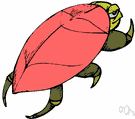carapace
Also found in: Thesaurus, Medical, Encyclopedia, Wikipedia.
Related to carapace: gastric mill, Swimmerets
car·a·pace
(kăr′ə-pās′)n.
1. Zoology A hard bony or chitinous outer covering, such as the fused dorsal plates of a turtle or the portion of the exoskeleton covering the head and thorax of a crustacean.
2. A protective, shell-like covering likened to that of a turtle or crustacean: "He used to worry that Sarah would age the same way, develop the same brittle carapace" (Anne Tyler).
[French, from Spanish carapacho.]
American Heritage® Dictionary of the English Language, Fifth Edition. Copyright © 2016 by Houghton Mifflin Harcourt Publishing Company. Published by Houghton Mifflin Harcourt Publishing Company. All rights reserved.
carapace
(ˈkærəˌpeɪs) orcarapax
n
(Zoology) the thick hard shield, made of chitin or bone, that covers part of the body of crabs, lobsters, tortoises, etc
[C19: from French, from Spanish carapacho, of unknown origin]
Collins English Dictionary – Complete and Unabridged, 12th Edition 2014 © HarperCollins Publishers 1991, 1994, 1998, 2000, 2003, 2006, 2007, 2009, 2011, 2014
car•a•pace
(ˈkær əˌpeɪs)n.
a bony or chitinous shield, test, or shell covering some or all of the dorsal part of an animal, as of a turtle.
[1830–40; < French < Sp carapacho]
car′a•paced`, adj.
Random House Kernerman Webster's College Dictionary, © 2010 K Dictionaries Ltd. Copyright 2005, 1997, 1991 by Random House, Inc. All rights reserved.
car·a·pace
(kăr′ə-pās′) A hard outer covering or shell made of bone or chitin on the back of animals such as turtles, armadillos, lobsters, and crabs.
The American Heritage® Student Science Dictionary, Second Edition. Copyright © 2014 by Houghton Mifflin Harcourt Publishing Company. Published by Houghton Mifflin Harcourt Publishing Company. All rights reserved.
ThesaurusAntonymsRelated WordsSynonymsLegend:
Switch to new thesaurus
| Noun | 1. |  carapace - hard outer covering or case of certain organisms such as arthropods and turtles carapace - hard outer covering or case of certain organisms such as arthropods and turtlesturtle - any of various aquatic and land reptiles having a bony shell and flipper-like limbs for swimming arthropod - invertebrate having jointed limbs and a segmented body with an exoskeleton made of chitin cuticula - the outer body wall of an insect scute - large bony or horny plate as on an armadillo or turtle or the underside of a snake mollusc, mollusk, shellfish - invertebrate having a soft unsegmented body usually enclosed in a shell shell - the material that forms the hard outer covering of many animals |
Based on WordNet 3.0, Farlex clipart collection. © 2003-2012 Princeton University, Farlex Inc.
Translations
panssari
Collins Spanish Dictionary - Complete and Unabridged 8th Edition 2005 © William Collins Sons & Co. Ltd. 1971, 1988 © HarperCollins Publishers 1992, 1993, 1996, 1997, 2000, 2003, 2005
Collins German Dictionary – Complete and Unabridged 7th Edition 2005. © William Collins Sons & Co. Ltd. 1980 © HarperCollins Publishers 1991, 1997, 1999, 2004, 2005, 2007